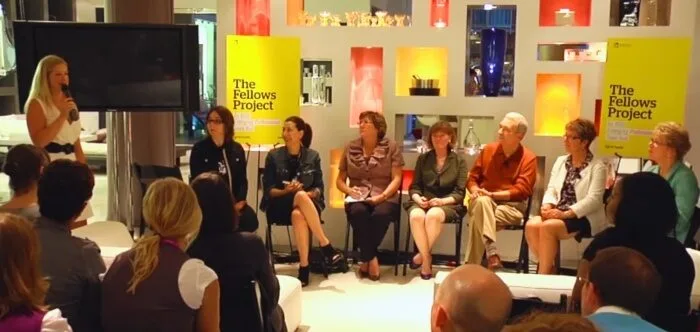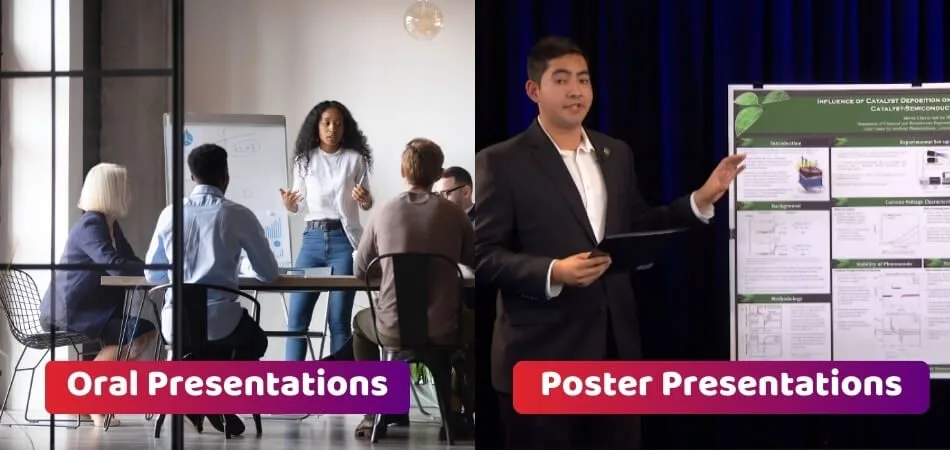Conferences serve as active platforms for sharing knowledge, bringing up discussions, and networking in various fields. A key aspect of these gatherings is how information is presented, which brings us to an important question: What are the two presentation formats that commonly appear at conferences?
The answer lies in two distinct styles. First, there are oral presentations, where speakers engage the audience with live talks, often supported by visual aids like slides to enhance understanding. Second, poster presentations offer a more interactive approach, displaying research findings on large posters, and inviting attendees to engage in one-on-one discussions.
For a deeper dive into the nuances of these formats, how they impact audience engagement, and tips for effective delivery, continue reading our comprehensive blog post.
A Brief Overview of the Conference
Conferences are hubs of intellectual exchange, uniting professionals from diverse fields. These events offer a platform for sharing insights and promoting collaborations. Aside from that, attendees have plenty of opportunities to learn and network.

Joining a conference from overseas has transformative effects as participants gather. The presence of international participants enriches discussions and enhances cultural appreciation among participants. It’s a unique opportunity to explore differing viewpoints and discover new approaches to common challenges.
The success of a conference hinges on the quality and diversity of these presentations. They provide a dynamic environment for learning and debate. Each format caters to different aspects of knowledge sharing and audience engagement.
What is the Presentation Format at the Conference?
Presentation formats serve as essential tools for effectively sharing information with specific audiences, especially in conference settings. These formats vary, depending on the nature of the content and the audience’s preferences. Typically, they include slideshows, speeches, panel discussions, and interactive workshops.
In a conference context, slideshows are often the most common format, utilizing tools like PowerPoint or Keynote. This format allows speakers to visually complement their spoken content with graphs, images, and bullet points. It’s particularly useful for summarizing complex information or data in an accessible way.
Another popular format at conferences is the panel discussion, which involves a group of experts discussing a topic in front of an audience. This interactive and dynamic format encourages diverse perspectives and audience engagement. It’s ideal for exploring different viewpoints on a subject and raising a deeper understanding through discussion.
Types of Presentation Formats Used at Conference
Conferences are a melting pot of ideas, where various presentation formats play a pivotal role. These formats are designed to cater to various informational needs and audience engagement levels. Here, we explore the different types of presentation formats used at conferences.
Oral Presentations
Oral presentations are a staple at conferences, offering a direct way to communicate research. Speakers typically use slides to enhance their talk, making complex information easier to digest. This format is ideal for detailed explorations of topics in a concise manner. Audience engagement is often high, thanks to the interactive nature of Q&A sessions.
Poster Presentations
Poster presentations turn research into visual stories, displayed on large posters. This format encourages informal discussions, allowing for deeper dives into specific aspects of the research. Attendees can engage directly with the presenter, rearing a more personalized interaction. It’s a great way for early-career researchers to gain visibility and feedback.
Panel Discussions
Panel discussions bring together experts to debate or discuss a specific topic. This format upbringing a dynamic exchange of ideas and viewpoints. Audience members benefit from the diverse perspectives of panelists. It’s an excellent way to explore complex issues in a multifaceted way.
Workshops
Workshops are interactive sessions where participants learn by doing. They’re often hands-on, focusing on skill development or problem-solving. These sessions are typically smaller, creating a more intimate learning environment. Workshops are ideal for practical demonstrations and in-depth training.
Roundtable Sessions
Roundtable sessions offer a more informal discussion format. Small groups gather around a table to discuss specific topics or issues. These sessions encourage participation from all attendees, making them highly interactive. They’re great for networking and sharing best practices.
Keynote Speeches
Keynote speeches are delivered by prominent figures in the field. They set the tone for the conference and highlight major themes. Keynotes are usually inspirational, providing big-picture insights. They’re a highlight for many attendees, offering a chance to hear from leading voices.
Each of these formats has its unique advantages, shaping the way information is exchanged and absorbed at conferences. They collectively enrich the conference experience, ensuring a dynamic and engaging learning environment.
What Are the Two Presentation Formats That Commonly Appear at Conferences?
Conferences are active platforms for knowledge exchange and innovation. Key to their success are the presentation formats chosen to spread information. In this exploration, we dive into what are the two presentation formats that commonly appear at conferences:
Oral Presentations
Oral presentations are a powerful and direct way of communicating research and ideas. In this format, speakers address the audience live, often assisted by visual aids such as slides or videos. These presentations are typically structured, with a clear beginning, middle, and end, guiding the audience through the content logically. The interactive element, usually a question-and-answer session, allows for immediate engagement and clarification, making it a popular choice for many conferences.
The effectiveness of oral presentations largely depends on the speaker’s ability to connect with the audience. It’s not just about what is said, but how it’s conveyed – tone, pace, and body language all play crucial roles. This format is ideal for presenting new research findings, theoretical concepts, or case studies. It allows for a comprehensive overview of a topic within a limited time frame, making it efficient and informative.
Poster Presentations
Poster presentations offer a visually engaging and more interactive alternative. In this format, presenters create a poster summarizing their research or findings, which is displayed in a designated area. Attendees roam through these displays, allowing them to engage with multiple topics at their own pace. This format is particularly effective for detailed discussions, as it encourages one-on-one or small-group interactions.
Unlike oral presentations, the poster format provides a more relaxed environment for both presenters and attendees. Presenters get the opportunity to discuss their work in-depth, receiving immediate feedback and engaging in meaningful discussions. For attendees, it’s an opportunity to dive deeper into specific topics of interest and network with peers. This format is especially beneficial for emerging researchers looking to gain visibility and connect with others in their field.
These two formats, oral and poster presentations, complement each other in providing a comprehensive and engaging conference experience. They cater to different styles of learning and interaction, ensuring that all attendees have the opportunity to absorb and contribute to the shared pool of knowledge.
Considerations for Choosing the Appropriate Presentation Format
Choosing the right presentation format for a conference is a crucial decision that can significantly impact the effectiveness of your message. Various factors influence this choice, ensuring that your content is not only well-received but also leaves a lasting impression. It’s about matching the format to both your material and the audience’s expectations.
- Audience Engagement: If your goal is to interact directly with the audience, consider an oral presentation. It allows for real-time questions and discussions, facilitating lively engagement.
- Content Complexity: For complex topics requiring detailed explanations, oral presentations are usually more effective. They provide the opportunity to elaborate on intricate points and ensure clarity.
- Research Detail: Poster presentations are ideal for showcasing research with rich visual data. They allow attendees to absorb detailed information at their own pace, encouraging thoughtful engagement.
- Networking Opportunities: If networking is a priority, opt for a poster presentation. This format boost personal interactions, making it easier to connect with peers and experts.
- Time Constraints: Oral presentations are time-bound, making them suitable for concise, impactful messages. They demand careful timing and precision in delivery.
- Venue Considerations: Consider the available space and resources at the conference. Some venues are better suited for large-scale poster displays, while others may favor speaker-led sessions.
In making your choice, balance the needs of your content with the dynamics of audience interaction. The right format not only conveys your message effectively but also enhances the overall conference experience. Remember, the goal is to communicate your ideas in the most engaging and accessible way possible.
Essential Tips for Preparing an Effective Presentation
Creating an effective presentation is a valuable skill that can make a significant difference in conveying your message effectively at conferences. To help you prepare an engaging and impactful presentation, consider these essential tips:
Know Your Audience
Understanding your audience is crucial. Tailor your content to their level of expertise and interests. This ensures that your presentation resonates with them and meets their expectations. For instance, if you’re presenting to a group of experts, delve into more technical details, whereas a general audience may require simplified explanations.
Structure Your Content
Organize your presentation with a clear structure. Start with an attention-grabbing introduction, followed by a well-organized body, and conclude with a memorable takeaway. A logical flow keeps the audience engaged. Utilize bullet points or numbered lists to make your content easy to follow.
Visual Aids Matter
Visual elements like slides or posters can enhance comprehension. Use visuals sparingly, ensuring they complement your narrative rather than overwhelm it. Keep slides uncluttered and easy to read. Incorporate relevant images, graphs, and charts to illustrate your points effectively.
Practice Your Presentation
Rehearse your presentation multiple times. Practice helps you refine your delivery, manage timing, and build confidence. Familiarity with the content reduces the chance of stumbling during your talk. Practice in front of a friend or colleague to receive constructive feedback.
Engage Your Audience
Encourage interaction. Ask questions, prompt discussions, or include interactive activities to involve the audience. Engagement keeps the audience attentive and reinforces key points. For example, you can use real-life examples or case studies to make the content relatable.
Effective Delivery
Focus on your delivery. Maintain eye contact, speak clearly and confidently, and use gestures to emphasize key points. A well-delivered presentation captures the audience’s attention and leaves a lasting impression. Consider recording yourself to identify areas for improvement in your presentation style.
By following these tips, you can craft and deliver a presentation that not only conveys your message effectively but also engages and inspires your audience. Your presentation can make a significant impact at conferences, leaving a positive and lasting impression.
Conclusion
Knowing the role of presentation formats at conferences is crucial for effective knowledge sharing and engagement. What are the two presentation formats that commonly appear at conferences?” brings the significance of oral and poster presentations, catering to different learning styles.
In the conference view, the choice of presentation format is strategic, impacting the overall experience. Tailoring content to the audience’s needs ensures resonance. Tips for effective presentations equip speakers to convey their message compellingly.
In essence, conference success hinges on the quality and diversity of presentations. Oral and poster formats provide a dynamic platform for knowledge exchange, rearing collaborations and sparking intellectual discussions.







